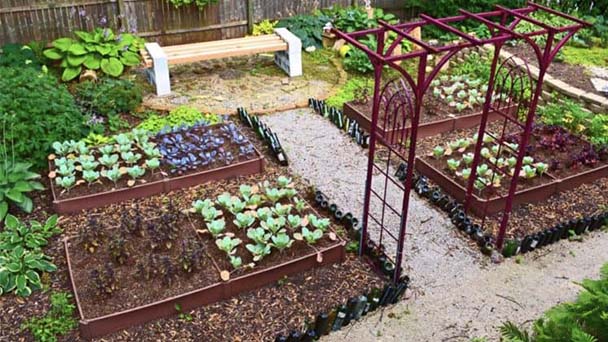Precautions and some vegetable garden ideas
Written by Joy
Sep 27 2020

As summer is gone, it is time to clean up the garden and plan to plant and begin your vegetable gardening in spring next year. It's time to water less trees and shrubs to make them more cold-resistant before winter comes. You should eliminate useless annual plants and compost. You can use these vegetable gardening precautions and ideas this month to help keep your garden looking its best for the rest of the season and prepare for the cold winter and upcoming spring. It;s time to manage annual plants, perennials and bulbous plants in autumn.

Once the top of the onion of vegetable gardening has withered, the bulb should be placed in a warm, dry, sunny place and dry for about 10 days. Then you'd better store it in a cool, cool, and dry place.
Some root crops of vegetable gardening, such as carrots and onions, can be left on the ground in cold climates and dig as needed. You could apply enough mulch to prevent freezing, and the crop will remain fresh until it needs to be picked.
After finishing the summer vegetable harvest, you could plant a mulch of clover, cow peas, soybeans or rootstock in the next spring. Those are all good ideas about vegetable gardens. These nitrogen fertilizer-producing plants will provide good organic matter and food for next year's garden crops and help control weeds in winter.

The soil temperature of vegetable gardening
The soil temperature of vegetable gardening decreases in autumn, and spring bulbs such as tulips, daffodils, hyacinths and crocuses should be planted. You can choose healthy, disease-free bulbous plants and vegetables. When preparing the soil, adding bone meal or chemical fertilizer is suitable to the planting hole. Pansies in winter, ornamental cabbage and cabbage, and chrysanthemums blooming in autumn can now be planted. After the summer flowers fade, which will give the garden some color. You can plant wildflower seeds or seeds of vegetables this month, so that the seedlings can be transplanted to a fixed location next spring. As the weather gets colder and perennials have overgrowth or become crowded, they should be dug out, separated or moved to new areas of the garden. New and replacement perennials should also be planted this month.Harvesting fruits and vegetables
Harvesting fruits and vegetables is the happiest and most meaningful time to grow fruits and vegetables. Under normal circumstances, you may not only eat these vegetables and fruits gardening by yourself, but also you can share the harvest of pumpkins and tomatoes with friends and neighbors. Although most fruits and vegetables gardening taste best on the day they are picked, you can extend their shelf life by freezing, drying, storing or canning.Check regularly for maturity
Fruits and vegetables of vegetable gardening should be checked regularly for maturity. Practical experience will tell you that when the fruits and vegetables are the most delicious, it is the harvest day. Pruning should be done after the harvest to ensure a good harvest next year.Once the top of the onion of vegetable gardening has withered, the bulb should be placed in a warm, dry, sunny place and dry for about 10 days. Then you'd better store it in a cool, cool, and dry place.
Some root crops of vegetable gardening, such as carrots and onions, can be left on the ground in cold climates and dig as needed. You could apply enough mulch to prevent freezing, and the crop will remain fresh until it needs to be picked.
After finishing the summer vegetable harvest, you could plant a mulch of clover, cow peas, soybeans or rootstock in the next spring. Those are all good ideas about vegetable gardens. These nitrogen fertilizer-producing plants will provide good organic matter and food for next year's garden crops and help control weeds in winter.
Latest Updated
- Benefits of Bugleweed - 7 Science-backed Health Benefits
- Bugleweed Dangers & Side Effects - Is It Poisonous?
- How to Plant Evergreen Trees - What You Should Know
- When to Plant Evergreens - Grow Guide for Evergreen Trees
- 12 Wonderful Evergreen Shrubs for Your Garden
- 12 Popular Evergreen Plants with Pictures for Beginners
- When And How To Prune A Lilac Bush Like a Pro
- How to Grow & Care for Lilac Vine (Hardenbergia Violacea)
- Japanese Lilac Tree (Syringa Reticulata) Care & Propagation Guide
- Shumard Oak Pros and Cons - What to Know
Popular Articles
- Winter maintenance of Antirrhinum Majus
- How to Grow Terminalia Mantaly Tree
- How to Grow and Care for Crossostephium Chinense
- How to grow Antirrhinum Majus in spring
- Peristeria Elata (Dove Orchid) Profile: Info & Care Guide
- Underwatered Snake Plant (Sansevieria Trifasciata) - Signs And How To Fix
- How to Care for Brazilian Jasmine Plant (Mandevilla Sanderi)
- How to Grow & Care for Graptopetalum Purple Delight in Summer
- Rosa Chinensis (China Rose): Plant Growing & Care Tips
- How to Care for Baby Sun Rose (Aptenia Cordifolia)